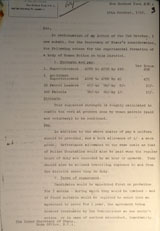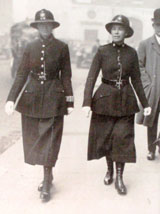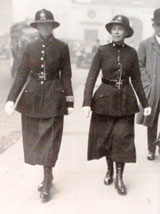The First Women Police Officers

The utility of women in preventing crime and maintaining public order on the streets was seen by some senior police officers. Indeed, the Commissioner paid for a small number of the women's patrols. As can be seen in his 1918 report, the Commissioner was keen to stress that while this work was 'not strictly the duty of the police, [it] is yet closely allied to it'. He proposed to bring the women patrols under the control of the Metropolitan Police, using the supervisor of the NUWW, Mrs Sophia Stanley, to superintend their work. In a subsequent letter the Commissioner explained how he envisaged the women police functioning.
On 16 November 1918 formal notice was given to the NUWW that existing arrangements would be terminated, this was followed by an outline of the Commissioner's proposals for a women police force.
The other womens' police organisation, the Women Police Service, was sidelined largely because of its link with militant feminist causes. Police Orders for 22 November 1918 outline the formation of the Women Police with the appointment of Mrs Stanley as its Superintendent. It proposed ten supervisors to direct 100 female police officers.
An order issued a month later outlined the qualifications required for potential recruits and the conditions of enrolment. In line with requirements for male officers, a minimum height was established, though at 5 feet 4 inches this was considerably lower than that for men. There are three important things worth noting here: first, women with dependant young children were barred from service; second, alongside pay and conditions, the order stresses that women officers were not to be sworn in as constables; and third, they had no right to a pension.
By 17 February, 25 women officers had been appointed. The last officer to be detailed in Police Orders is a notable figure. Lilian Wyles, as her central record of service demonstrates, ended her career as an inspector. Alongside publishing her memoirs (Woman and Scotland Yard (1952)), on her retirement she lectured and broadcast on police matters and child welfare. On her death, in 1975, she was listed in Who Was Who. Wyles's record details her date of birth, appointment, commendations, promotions and pension; by the time of her retirement the pension was awarded to women. It is also notable that, in 1949, she was awarded the British Empire Medal.
While women had proved themselves during the war, their success as women police officers (without the full powers of a constable) was short-lived. Britain in the years following the First World War was in dire economic straits. On 23 November 1918 the Prime Minister, David Lloyd George, promised a package of social reforms for the nation. These included the extension of pensions and national insurance, and a pledge to improve the low quality of housing. However, middle-class concern at rising public expenditure – fuelled by rising taxes – and a widespread belief that Britain needed to adopt the pre-war gold standard (a system of fixed exchange rates which valued £1 at $4.86) severely restricted post-war reconstruction. A National Committee on Expenditure recommended cuts in public expenditure; the ensuing cuts became known as 'Geddes Axe' in 1922. As we saw earlier, the commissioner had stressed that the activities of women officers were not 'proper' police work. The women were an easy target for cuts in public expenditure, and the Women Police was abolished.
Disbandment led a number of female officers to complain to their superintendent. One of the signatories was Lilian Wyles. The women officers wished their concerns to be forwarded to the Prime Minister. The resolution states:
Women Patrols of all ranks having received today from the Superintendent the memorandum from the Commissioner of Police terminating their services, and having read the statement in the Geddes Report that "their utility from a Police point of view is, on the evidence submitted negligible", in view of the fact that no evidence was taken from any officer of the Women Patrols Division, nor any record of recent work called for to submit to the Geddes Committee, respectfully ask permission to approach the Prime Minister by means of a deputation, with their Superintendent to speak for them and lay their case before him.
It is notable that the women were keen to resolve the matter through police channels rather than pursuing their grievance through any of the 'women's organizations'. They stressed also 'their utmost loyalty to you, to the Commissioner and to all the officials under whom they are proud to serve'. Some women suffered directly as a result of the temporary disbandment. The National Council of Women later wrote to the Commissioner to complain that Mrs Westlake, for example, was not eligible to a pension, as the disbandment of the women police meant that she failed to complete 10 years of service. The police refused to treat her as a special case.

But abolition under the Geddes Axe was short lived. In 1923 fifty officers were re-sworn, and this time with full powers of arrest, under the leadership of Inspector Clayden. By 1939 the Metropolitan Police employed 155 officers. London was the largest city in the country but this was a significantly higher number than were employed in other urban areas such as Glasgow (14), Birmingham (13) and Manchester (6). Changes in society ushered in by the First World War contributed to the desire to develop and maintain women police. For example, the 'public' was no longer viewed as an inherently masculine sphere – the work of women in munitions factories was one change that had laid rest to that idea. Chaperoning was on the wane, and a number of new leisure venues, such as cafes and teashops, catered for a female clientele. Big cities, and London in particular, were believed to pose special opportunities, and threats, to women and the tasks of women police were strictly confined by gender perceptions.
 WPC 18 Ellis and Inspector Clayden patrolling outside Bow Street Police Station, 1924.
WPC 18 Ellis and Inspector Clayden patrolling outside Bow Street Police Station, 1924.